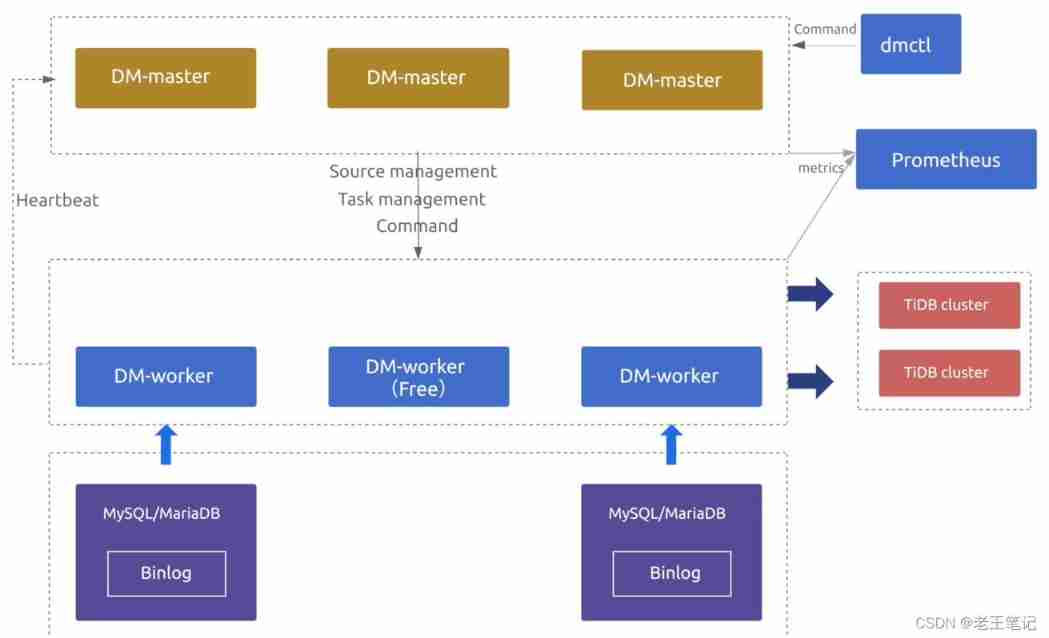当前位置:网站首页>Redis learning journey - cache exceptions (CACHE penetration, cache avalanche, cache breakdown)
Redis learning journey - cache exceptions (CACHE penetration, cache avalanche, cache breakdown)
2022-06-13 07:28:00 【Zhao JC】
Cache exception
Redis The use of caching , Greatly improve the performance and efficiency of the application , Especially in data query . But at the same time , It also brings some problems . among , The most important question , Namely
The consistency of data , Strictly speaking , This problem is more complicated . If there is a high requirement for data consistency , Then you can't use caching . Other typical problems are ,
Cache penetration 、 Cache avalanche and cache breakdown . at present , There are also popular solutions in the industry . Data consistency
background
background : Use to cache , Whether it is caching in local memory or using Redis Do the cache , Then there will be the problem of data synchronization , Cause the inconsistency between the database and the buffered data
Solution
- Update the database first , Update cache after
- Update cache first , Update the database after
- So let's delete the cache , Update the database after
- Update the database first , Delete cache after
The problems of the first scheme : In the scenario of concurrent database update , Will brush dirty data into the cache
The problems of the second scheme : If you update the cache first , But the database update failed , It will also cause the problem of inconsistency in the poem
Therefore, the first and second schemes are generally not used , And use threeorfour schemes
So let's delete the cache , Update the database after
The third solution also has problems , At this point, there are two requests , request A( update operation ) And request B( Query operation )
- request A Write operation , Delete cache ( But the database has not been updated yet )
- request B Query found that the cache does not exist
- request B The old value is obtained by querying the database
- request B Write old values to the cache
- request A Update the new value to the database
The above situation will lead to data inconsistency , And if you do not set the expiration time policy for the cache , This data is always dirty data , So how to solve it Answer 1 : Delay double delete
Pseudo code :
public void write(String key, Object data) {
Redis.delkey(key);
db.uppdateDate(data);
Thread.sleep(1000);
Redis.delkey(key);
}
- Eliminate the cache first
- Write the database again
- Sleep for a second , Eliminate the cache again ( Do it , Can be 1s Cache dirty data caused by , Delete again ) Ensure that after the request is completed , The write request can delete the dirty cache data caused by the read request again
Answer two : Update and read operations are asynchronously serialized
- Asynchronous serialization
- Read to remove heavy
So let's delete the cache , Update the database after
There will be problems in this situation , For example, updating the database is successful , However, there was an error in deleting the cache stage. The deletion was not successful , At this time, when reading the cache, the data is always wrong 
Solution : Use message queuing for deletion compensation
- request A Update the database first
- Right again Redis Failed to delete , Report errors
- here Redis Of key Send it to the message queue as the message body
- After receiving the message sent by the message queue, the system sends the message to Redis Delete operation
Cache penetration ( Not found in a large area )
Concept
The concept of cache penetration is simple , The user wants to query a data , Find out redis Memory databases don't have , That is, cache miss , So query the persistence layer database . There is no , So this query failed . When there are a lot of users , No cache hits ( seckill !), So they all went to the persistence layer database . This will put a lot of pressure on the persistence layer database , This is equivalent to cache penetration .
Solution
- The bloon filter
A bloom filter is a data structure , For all possible query parameters, use hash stored , Check at the control level first , If not, discard , Thus, the query pressure on the underlying storage system is avoided ;
- Caching empty objects
When the storage tier misses , Even empty objects returned are cached , At the same time, an expiration time will be set , Then accessing this data will get from the cache , Protected back-end data sources ;
But there are two problems with this approach :
- If null values can be cached , This means that the cache needs more space to store more keys , Because there may be a lot of The null value of the key ;
- Even if expiration time is set for null value , There will be some inconsistency between the data of cache layer and storage layer for a period of time , This is for Businesses that need to be consistent have an impact .
Cache breakdown ( Too much , Cache expiration !)
Concept
We need to pay attention to the difference between this and cache breakdown , Cache breakdown , It means a key Very hot , Constantly carrying big concurrency , Large concurrent set
Access this point , When this key At the moment of failure , Continuous large concurrency breaks through the cache , Direct request database , It's like cutting a hole in a barrier .
When a key At the moment of expiration , There are a lot of requests for concurrent access , This kind of data is generally hot data , Due to cache expiration , Will access the database at the same time to query the latest data , And write back to the cache , Will cause the database transient pressure is too large .
Solution
- Never expired data settings
At the cache level , Expiration time is not set , So there will be no hot spots key Problems after expiration .
- Add mutex lock
Distributed lock : Using distributed locks , Guarantee for each key At the same time, there is only one thread to query the back-end service , Other threads do not have access to distributed locks , So just wait . In this way, the pressure of high concurrency is transferred to distributed locks , So the test of distributed locks is great .
Cache avalanche ( power failure / Downtime )
Concept
Cache avalanche , At a certain time , Expiration in cache set .Redis Downtime !
One of the reasons for the avalanche , For example, when writing this article , It's about double twelve o'clock , There will soon be a rush , This wave of commodity time is put into the cache , Suppose you cache for an hour . Then at one o'clock in the morning , The cache of this batch of goods has expired . And the access to this batch of products , It's all in the database , For databases , There will be periodic pressure peaks . So all the requests will reach the storage layer , The number of calls to the storage layer will skyrocket , Cause the storage layer to hang up .
Actually, the concentration is overdue , It's not very deadly , More deadly cache avalanche , It means that a node of the cache server is down or disconnected . Because of the cache avalanche formed naturally , Cache must be created in a certain time period , This is the time , The database can also withstand the pressure . It's just periodic pressure on the database . The cache service node is down , The pressure on the database server is unpredictable
Of , It's likely to crush the database in an instant .
Solution
- redis High availability
The meaning of this idea is , since redis It's possible to hang up , I'll add more redis, After this one goes down, others can continue to work , In fact, it's a cluster built .( Different live !)
- Current limiting the drop
The idea of this solution is , After cache failure , Control the number of threads that read the database write cache by locking or queuing . For example, to some key Only one thread is allowed to query data and write cache , Other threads wait .
- Data preheating
Data heating means before deployment , I'll go through the possible data first , In this way, some of the data that may be accessed in large amounts will be loaded into the cache . Manually trigger loading cache before large concurrent access occurs key, Set different expiration times , Make the cache failure time as uniform as possible .
边栏推荐
- Awk use
- redis-5. Redis' RDB, fork, copyonwrite, AOF, RDB & AOF are mixed
- Socket programming 2:io reuse (select & poll & epoll)
- Mui mixed development - when updating the download app, the system status bar displays the download progress
- powerdisgner逆向生成oracle数据模型
- 6. system call
- 快速排序
- MySQL row column conversion (updated version)
- Que se passe - t - il si les produits financiers sont nuls pendant plusieurs jours?
- nodejs文件模块fs
猜你喜欢

Mui mixed development - when updating the download app, the system status bar displays the download progress

Tidb data migration (DM) Introduction

How to write an amazing design document?

Un des backtraders du cadre de quantification lit l'analyseur

Compare advantages and disadvantages of DFS and BFS and name vocabulary

Powerdispatcher reverse generation of Oracle data model

Problems encountered during commissioning of C # project

oracle问题,字段里面的数据被逗号隔开,取逗号两边数据

量化框架backtrader之一文讀懂Analyzer分析器
![[vivefocus uses the wavevr plug-in to obtain handle operation events]](/img/4f/2ca02799ef5cde1a28101d61199856.jpg)
[vivefocus uses the wavevr plug-in to obtain handle operation events]
随机推荐
Table access among Oracle database users
【硬记】脏读、不可重复读、幻读场景核心区别
A solution to the problem that there is always a newline character when C merges multiple RichTextBox contents
About database: pgadmin4 editing SQL window
Related operations under Oracle Database
基于ESP32CAM实现WebSocket服务器实时点灯
SDN基本概述
RT-Thread 模拟器 simulator LVGL控件:slider 控件
How to use clion to debug a project built by the make tool
Sorting of numbers and strings
FTP_ Manipulate remote files
不同系统添加证书
量化框架backtrader之一文讀懂Analyzer分析器
Pdf to word
Reflection of C # Foundation
TCP协议的三次握手过程和四次挥手过程以及为什么要这样? ------一二熊猫
Local file upload FTP or remote directory
RT-Thread 模拟器 simulator LVGL控件:button 按钮事件
5. interrupts and exceptions
Sharp weapon tcpdump